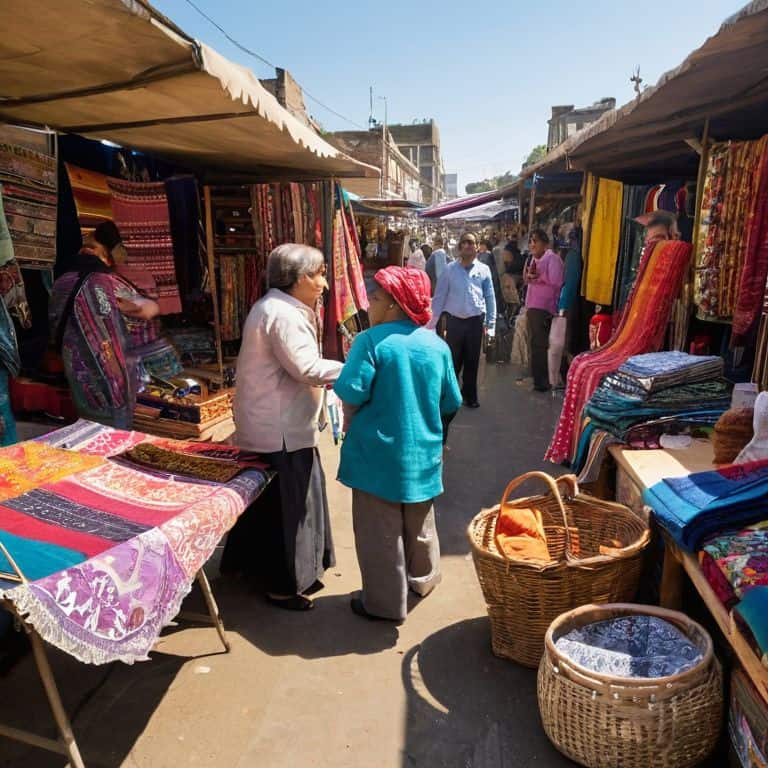I still remember the first time I attempted to haggle in a market – I was a wide-eyed teenager, traveling with my family in Morocco. My parents, seasoned diplomats, had warned me about the art of gentle bargaining, but I was determined to try it out for myself. As I wandered through the vibrant souks, I found myself face to face with a charismatic vendor, who was eager to sell me a beautiful handmade rug. I stumbled over my words, unsure of how to haggle respectfully, and ended up paying a hefty price for the rug. It was a valuable lesson, one that taught me the importance of understanding the nuances of how to haggle respectfully in markets.
As I’ve traveled the world, collecting stories and recipes from local artisans, I’ve come to realize that haggling is an art form that requires patience, empathy, and a deep understanding of the cultural context. In this article, I’ll share my honest, no-hype advice on how to haggle respectfully in markets, from the dos and don’ts of body language to the secrets of building rapport with vendors. My goal is to empower you with the skills and confidence to navigate even the most intimidating markets with ease, and to walk away with not only amazing deals but also meaningful connections with the people you meet along the way.
Table of Contents
- Guide Overview: What You'll Need
- Step-by-Step Instructions
- Mastering Market Harmony
- The Art of Gentle Bargaining: 5 Tips to Harmonize Your Market Experience
- Embracing the Rhythm of the Market: 3 Key Takeaways
- The Heart of the Bargain
- Embracing the Art of Respectful Hagging
- Frequently Asked Questions
Guide Overview: What You'll Need

Total Time: 1 hour
Estimated Cost: Free – $0 (since haggling is a skill)
Difficulty Level: Intermediate
Tools Required
- Knowledge of market prices (research beforehand to understand average prices)
- Polite demeanor (smile and be respectful during negotiations)
- Basic math skills (calculate percentages and prices quickly)
Supplies & Materials
- Cash for purchases (have local currency for easy transactions)
- Small notebook and pen (for recording prices and notes during the market visit)
Step-by-Step Instructions
- 1. First, immerse yourself in the local culture by learning a few key phrases in the native language, such as “how much” and “thank you.” This simple act of respect can go a long way in setting a positive tone for your haggling experience. I recall a time when I was in a bustling market in Morocco, and my attempts at speaking Arabic with the vendors not only earned me a few warm smiles but also landed me some remarkable deals.
- 2. Upon entering the market, take your time to absorb the sights, sounds, and aromas around you. Don’t rush into any purchases or negotiations. Instead, wander through the stalls, and let the vendors approach you. This will give you a chance to gauge the atmosphere and get a feel for the prices and quality of the goods on offer. I’ve found that building a rapport with the vendors, even if it’s just through a shared laugh or a comment about the weather, can make the haggling process much more enjoyable and successful.
- 3. When you find an item that catches your eye, start with a compliment. Express your genuine admiration for the product, and ask the vendor about its origins, materials, or craftsmanship. This not only shows your appreciation for their work but also demonstrates that you value the item beyond its monetary worth. I once praised a artisan’s handmade pottery in a small village in Italy, and he was so pleased that he offered me a significant discount, saying, “You understand the soul of this piece.
- 4. Begin with a lower offer than you’re willing to pay, but make sure it’s still within a reasonable range. The goal is to start a conversation, not to insult the vendor. Remember, haggling is a dance, and you’re both partners in this negotiation. Be prepared to listen actively and respond thoughtfully to the vendor’s counteroffers. In many cultures, the initial price is not set in stone, and the vendor may be willing to negotiate, but you need to approach the situation with respect and empathy.
- 5. As you negotiate, pay attention to nonverbal cues, such as body language and tone of voice. If the vendor seems uncomfortable or unyielding, it may be time to reassess your offer or politely decline. On the other hand, if the atmosphere remains friendly and open, you can continue to build on the rapport you’ve established, finding a mutually beneficial price. I’ve learned to recognize when a vendor is willing to compromise, and that’s often when the real negotiation begins.
- 6. Be transparent about your budget, but also be strategic. If you’re looking to purchase multiple items, consider letting the vendor know, as they may be willing to offer a discount for bulk purchases. However, don’t reveal your maximum budget too early in the negotiation, as this can limit your room for maneuver. Instead, focus on finding a price that works for both parties, and be willing to walk away if the deal isn’t right. This shows that you’re not desperate, and the vendor may be more inclined to meet you halfway.
- 7. Once you’ve reached a mutually agreeable price, seal the deal with a smile and a firm handshake. Thank the vendor, and show your appreciation for their flexibility and hospitality. This final step is just as important as the initial negotiation, as it leaves a positive impression and can lead to future opportunities and recommendations. As you walk away with your purchase, remember that the true value lies not only in the item itself but also in the story and connection you’ve created with the vendor and the local community.
Mastering Market Harmony

As I delve deeper into the world of market harmony, I’ve come to realize that respectful negotiation techniques are not just about getting a good deal, but also about building connections with the vendors. It’s about understanding the cultural nuances that govern the marketplace, and being mindful of the cultural differences in bargaining that can make or break a transaction. For instance, in some cultures, it’s customary to engage in lengthy conversations before even discussing prices, while in others, a straightforward approach is preferred.
When navigating these complex market dynamics, it’s essential to be aware of body language in haggling, as a simple gesture or expression can convey a wealth of information. A gentle smile, a nod of appreciation, or a respectful bow can go a long way in establishing a rapport with the vendor, making the negotiation process much smoother. Additionally, being mindful of common haggling mistakes to avoid, such as being too aggressive or dismissive, can help you steer clear of potential pitfalls and focus on finding a mutually beneficial agreement.
By embracing these principles, you’ll not only become a more effective negotiator but also a more empathetic and culturally sensitive traveler. Remember, the goal of market etiquette is not just to save money, but to foster meaningful connections with the people and places you encounter. As you wander through the vibrant stalls and markets, take the time to appreciate the price negotiation strategies that vendors use, and don’t be afraid to learn from them.
Deciphering Cultural Differences in Bargaining
As I’ve wandered through markets from Marrakech to Mumbai, I’ve come to realize that bargaining is not just about numbers, but about nuances. In some cultures, a gentle smile and a soft voice can be just as effective as a clever quip or a well-timed walk-away. I recall a memorable encounter in a Moroccan souk, where a vendor’s offer of sweet tea transformed a tense negotiation into a warm conversation. It’s these subtle cues that can make or break a deal, and understanding them is key to mastering the art of respectful haggling. By tuning into local customs and body language, you can navigate even the most unfamiliar marketplaces with ease and empathy.
Respectful Negotiation Techniques
As I delve deeper into the world of market harmony, I’ve come to realize that respectful negotiation techniques are the backbone of a truly enriching experience. It’s about understanding the vendor’s story, their struggles, and their passions. I recall a vendor in Marrakech who shared with me the ancient secrets of his family’s spice blends, and in that moment, the haggling transformed into a beautiful dance of mutual respect. By showing genuine interest and empathy, you can transcend the mere transaction and forge a connection that goes beyond the price tag.
In this delicate balance, a gentle smile, a nod of appreciation, and a willingness to listen can be just as valuable as the coins in your pocket. The goal is not to “win” the negotiation, but to find a mutually beneficial rhythm that leaves both parties feeling seen and heard. As you navigate the vibrant stalls, remember that every exchange is an opportunity to weave a richer tapestry of understanding and connection.
The Art of Gentle Bargaining: 5 Tips to Harmonize Your Market Experience
- Let the vendor make the first offer, and use that as a starting point to begin your gentle dance of negotiation, remembering that the goal is to find a mutually beneficial price
- Smile, make eye contact, and use open, expressive body language to show your genuine interest in the item and your willingness to engage in a respectful dialogue
- Avoid making overly aggressive or rapid-fire offers, instead opting for a calm and thoughtful approach that allows both parties to feel heard and understood
- Be willing to walk away if the price isn’t right, but do so with a gracious smile and a kind word, leaving the door open for a potential return and a continued conversation
- Learn a few key phrases in the local language, such as ‘how much?’ or ‘that’s a bit expensive,’ to show your respect for the culture and your commitment to fair, respectful bargaining
Embracing the Rhythm of the Market: 3 Key Takeaways
I’ve found that respectful haggling is not just about the price, but about the story you tell and the connection you make with the vendor – it’s a delicate dance of give and take, where everyone walks away with a smile
Deciphering cultural differences in bargaining is crucial, whether it’s understanding the polite refusal in Japanese markets or the enthusiastic banter in Indian bazaars, each place has its own unique rhythm and language
Mastering market harmony is about being present, attentive, and genuinely curious about the people and products around you – it’s a mindset that transforms haggling from a transaction into a meaningful encounter, a celebration of human connection in the unlikeliest of places
The Heart of the Bargain
Haggling isn’t just about the price; it’s about the dance between two strangers, where every step, every smile, and every concession is a testament to the beauty of human connection in the unlikeliest of places – the marketplace.
Anika Sharma
Embracing the Art of Respectful Hagging

As I reflect on my journey through the vibrant markets of the world, I’m reminded that haggling is an art form that requires patience, empathy, and a deep understanding of the local culture. By mastering market harmony and respecting the rhythms of the marketplace, we can transform our interactions with vendors into meaningful connections. I’ve shared with you the importance of respectful negotiation techniques, deciphering cultural differences in bargaining, and embracing the beauty of gentle bargaining. These principles have guided me through my travels, allowing me to forge unforgettable relationships with the people I’ve met along the way.
As you embark on your own adventures, I encourage you to approach haggling not just as a means to an end, but as a celebration of human connection. By doing so, you’ll find that the true treasures of the market lie not in the items you purchase, but in the stories, traditions, and friendships you discover along the way. So, go forth and haggle with heart, with curiosity, and with a deep appreciation for the people and cultures that make our world such a rich and wondrous place.
Frequently Asked Questions
What are some common gestures or body language cues that I should be aware of to avoid unintentionally offending a vendor during a haggle?
When haggling, be mindful of your body language – a gentle touch on the arm or a warm smile can go a long way, but avoid direct eye contact for too long, as it can be perceived as aggressive in some cultures. Also, keep your hands visible and avoid crossing your arms, which can give the impression you’re closed off to negotiation.
How can I effectively use humor to break the ice and build a rapport with a vendor, especially if we don't share a common language?
I’ve found that a well-timed laugh or a playful gesture can be a universal language. Try using self-deprecating humor or exaggerated expressions to show you’re approachable and willing to learn. I recall a vendor in Marrakech who couldn’t stop laughing at my attempts to pronounce Arabic phrases – it broke the ice and we ended up sharing a beautiful tea ceremony together.
In cultures where haggling is deeply ingrained, are there any specific phrases or expressions that I can learn to show respect and build trust with the vendor?
In Morocco, I’ve found that saying “As-salamu alaykum” (peace be upon you) before haggling sets a lovely tone. In India, a gentle “Namaste” or “Dhanyavad” (thank you) can work wonders. Learning these phrases shows you’re willing to understand and respect their culture, making the vendor more receptive to your negotiations.
